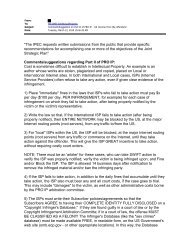We Energies Coal Combustion Products ... - The White House
We Energies Coal Combustion Products ... - The White House
We Energies Coal Combustion Products ... - The White House
You also want an ePaper? Increase the reach of your titles
YUMPU automatically turns print PDFs into web optimized ePapers that Google loves.
Compressive Strength of Concrete<br />
Containing <strong>We</strong> <strong>Energies</strong> ASTM C618,<br />
Class C Fly Ash (Phase I Study)<br />
Concrete is used in several applications requiring different levels of strength.<br />
Most applications require concrete with a compressive strength in the range of<br />
3,000 to 5,000 psi. Based on the type of application, engineers select a<br />
mixture design with a specified 28-day compressive strength. Other durability<br />
factors such as porosity or freeze-thaw resistance also influence the selection<br />
of a concrete mixture.<br />
With the introduction of fly ash concrete, the long-term (56 day or 1 year)<br />
properties of concrete have shown dramatic improvement. Since long-term<br />
properties of concrete are vital, most construction professionals are interested<br />
in understanding the performance of fly ash and the resulting concrete made<br />
using fly ash.<br />
<strong>The</strong> influence of <strong>We</strong> <strong>Energies</strong> fly ash on the quality of concrete has been<br />
studied for several years. Fly ash is used as a partial replacement for cement at<br />
various replacement levels. In order to understand the properties of <strong>We</strong><br />
<strong>Energies</strong> fly ash and the short-term and long-term performance of concrete<br />
containing <strong>We</strong> <strong>Energies</strong> fly ash, a great amount of research work has been<br />
conducted.<br />
<strong>The</strong> following data is from a research project conducted at the Center for By-<br />
<strong>Products</strong> Utilization at the University of Wisconsin-Milwaukee for <strong>We</strong><br />
<strong>Energies</strong> (24). This work was done with the objective of developing mixture<br />
proportions for structural grade concrete containing large volumes of fly ash.<br />
ASTM C618, Class C fly ash from <strong>We</strong> <strong>Energies</strong> Pleasant Prairie Power Plant<br />
was used in this research project.<br />
Preliminary mixture proportions were developed for producing concrete on a<br />
1.25 to 1 fly ash to cement weight basis replacement ratio. <strong>The</strong> replacement<br />
levels varied from 0 to 60% in 10% increments. Water to cementitious<br />
materials ratios (w/c) of 0.45, 0.55 and 0.65 were used in this project to<br />
develop concrete with strength levels of 3,000 psi; 4,000 psi and 5,000 psi. It<br />
is interesting to observe that at fly ash utilization levels rising above 50%,<br />
Portland cement becomes the admixture or supplementary cementitious<br />
material.<br />
Actual concrete production was performed at two local ready mixed concrete<br />
plants utilizing different cement and aggregate sources. Three quarter inch<br />
maximum size aggregates were used in the mixtures and the slump was<br />
maintained at 4”± 1”. Entrained air was maintained in the range of 5-6% ±<br />
1%. <strong>The</strong> concrete mixtures were prepared at ready mixed concrete plants<br />
using accepted industry practices. Six-inch diameter by 12” long cylinder<br />
specimens were prepared for compressive strength tests. <strong>The</strong> compressive<br />
<strong>We</strong> <strong>Energies</strong> 54<br />
<strong>Coal</strong> <strong>Combustion</strong> <strong>Products</strong><br />
Utilization Handbook



